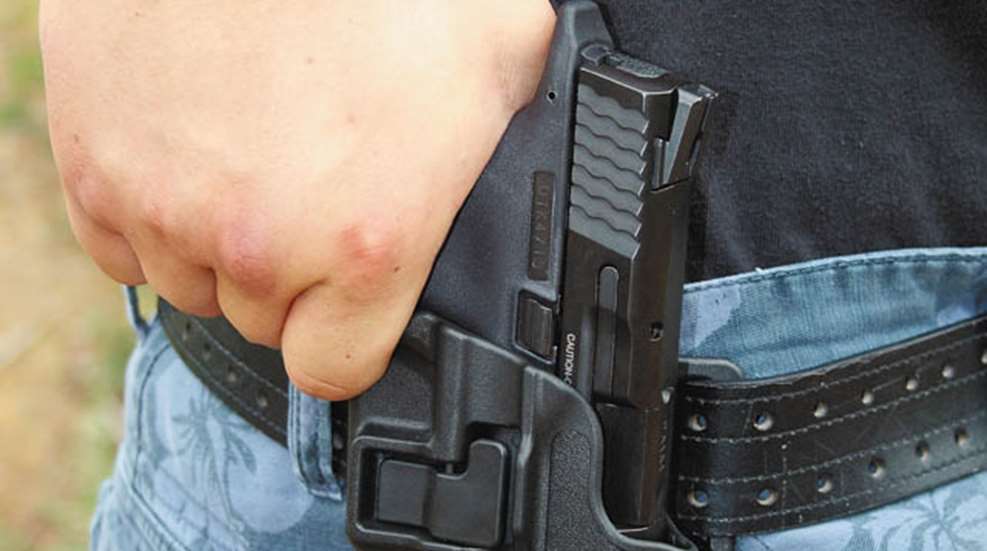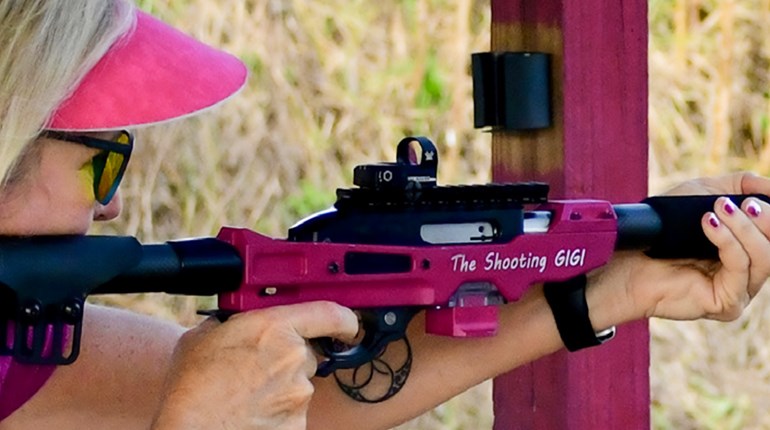
It has been said a wise man learns from his mistakes. It's also been said the definition of insanity is doing the same thing over and over and expecting a different result. Having worked with literally thousands of students over the last several years, I've seen many "unique" ways to handle a firearm. I've also encountered some very common errors or mistakes that prevent shooters from reaching their full potential. Here's how to avoid the top eight hurdles.
Park Your Ego!
Although women can be guilty of this, males are the primary culprits. The greatest obstacle to handgun mastery for most men is their ego. For whatever reason, men have an ingrained belief that the mere possession of a Y chromosome makes them excellent drivers, lovers and shooters. Honestly, we know this is not the case.

If you wanted to learn how to throw a 90-mph fastball you'd seek the instruction of a professional baseball coach, correct? Having found a coach, would you then argue with him that your dad taught you how to pitch and you don't need his help?
Similarly, you decide you want to learn judo. After some searching you secure training from the former coach of Team USA's Olympic judo team. After the first lesson, would you question the instructor's methods and then tell the coach how you'd like to be trained differently?
As ridiculous as it sounds, this is exactly what goes on at professional shooting schools. I have a close friend who is by all accounts a world-class firearms instructor. He has written books and received awards from his peers.
A few years ago he took a hiatus from teaching after becoming sick of ego-driven students. During one class, he got so fed up with an individual who kept interrupting and interjecting, he simply stopped speaking in the middle of the lesson. After a few moments of uncomfortable silence, he invited the know-it-all to the front of the group and offered to let him finish the lecture. The guy clammed up.

We all have varied levels of experience and backgrounds. When it comes to professional training, you should spend twice as much time listening as you do talking. If you're paying someone to teach you, park your ego and take in all that is being taught. You'll be amazed how much you can get out of the lesson.
Get a Grip
A solid firing grip begins with the dominant/strong hand. Your strong hand should grip the pistol firmly with the web of your hand high in the backstrap. This offers the greatest recoil control and consistency. The trigger finger is extended along the slide until the decision to fire is made. In addition, your strong thumb should be pointed in the direction of the target.
Your support hand wraps around the strong hand. Remember, the support hand supports. The goal of your grip should be to have as much contact between your hands and the frame as possible. Crossing thumbs, ducking the thumbs down, pointing both thumbs at the sky—all of these positions create an unnecessary gap between your hands and the pistol frame.

Keep it simple, stack your thumbs (strong hand atop weak) and point them both in the direction of the target. Remember, unlike a rifle where you have multiple anchor points, the only anchor points for your handgun are your left and right hands.
Maintain Your Grip
When it comes to shooting a handgun with dependable accuracy, a reliable and consistent grip is a must. Far too many shooters alter or change their grip during the shooting process. This hinders rapid presentation of the handgun and slows down projectile delivery on target.

We'll assume for the sake of this review you will start with a handgun secured in a belt holster of some sort. The proper draw stroke begins with the dominant hand gripping the pistol firmly and high on the backstrap. Trigger-finger placement is not a part of the gripping process. It remains extended straight, so when the pistol clears the holster, it will be indexed along the slide away from the trigger.
The shooting grip is achieved while the pistol is still in the holster. This is the grip you will use for the entire target engagement. Many shooters err by drawing the handgun, extending it toward the target and then pausing to readjust or correct their grip—a waste of time and effort. The moment your muzzle is indexed on target, you should be ready to engage the threat.
Trigger Finger
If you are doing everything right, the only muscles that should be moving the moment before your shot breaks are those in your trigger finger. The hands should be rock solid while the trigger finger does the work.
Again, for consistent accuracy your finger should always make contact with the trigger in the same place, both in relationship to the finger itself and the trigger.

Take a moment to look down at your trigger finger. We all have a unique fingerprint. That fingerprint (the pad of the trigger finger) is the portion that should be making contact with the trigger face.
There are many different trigger styles and designs, each with their own idiosyncrasies. As a general rule, I suggest finding the center point of the trigger both vertically and horizontally and pressing that point with the pad of your trigger finger.
Common errors in trigger-finger placement include hooking the finger all the way through so the first knuckle joint is on the trigger, or pushing on the trigger with the end/tip of the finger. Inconsistent trigger contact, where the shooter moves his finger from shot to shot, is also a frequent culprit in poor or inconsistent shot placement. Remember, don't jerk, snap or pull the pistol's trigger—press it.
Breaking the Shot
When you complete the trigger press, the handgun is going to move and make a very loud noise. The ingrained human response to loud noise is to flinch.

I've watched shooter after shooter fire their first shot with a pistol and the round strikes the center of the target. They then fire the second shot, and it's wildly off the mark. What went wrong? For the first shot, they were focused on the front sight and target, but during the second shot they were focused on the anticipated noise and recoil.
Recoil anticipation comes in two common forms: muzzle depression and muzzle elevation. Most of those who anticipate a shot will apply added pressure to the upper portion of the frame and push/dip the front sight down just as the trigger stroke is being completed. The result is a low shot.
A less-common, but still encountered, form of anticipation is "heeling" or adding undue pressure to the pistol with the heel of the palm just prior to the shot breaking. This pressure forces the front sight up just as the trigger trips the sear. The result is a shot far above the mark.

The solution for either form of anticipation is front sight focus. This is a complete, deliberate focus on the front sight, not just visually, but mentally as well. If you have a flinch or anticipation problem, I recommend actually saying front sight in your head as you press the shot. Your focus on the front sight should be so deliberate that you'll find the shot has broken before you had the opportunity to anticipate it. If you find you are focusing so intently that the shot breaks and gives you a surprise, you did it right.
Don't Fall Down
I was baptized a Weaver shooter nearly three decades ago. As a result, I was taught the proper angle to hold my feet and arms, and the correct percentage of weight that should be on the rear foot and on the front. A couple hundred thousand rounds later, what stance do I use now? The "me" stance.
I'm not trying to be arrogant, I've simply evolved. Rather than calculate angles and percentages, I try to hold to basic principles. Point your toes in the general direction of the target, flex your knees slightly (don't lock them), lean forward at the waist, putting the shoulders slightly ahead of your belly. Relax and shoot. That's it.

Is there a need for a precise, deliberate stance? Certainly, if you are shooting a slow-fire, known-distance course where a rigid platform with proper bone support is a key component to success.
Defensive or practical shooting (IPSC, IDPA, 3-gun) are different animals entirely as they are fluid events. By fluid I mean ever-changing. You will be moving to avoid incoming fire, to get to cover or to reach the next form of cover. Practical shooters are constantly on the move. Even if you have a shooting stance that would make Jack Weaver tear up with pride, the moment you take a step your perfect stance is gone. It's better to apply the basic principles of balance than to focus on angles and weight distribution.
Follow-Through
I'll address this element last, since it occurs after the shot has broken. Follow-through simply means to ride the recoil of the gun, reacquire your front sight and get back on target. Regardless of whether or not you intend to fire another shot, follow through.
Proper follow-though addresses both unconscious flinching and what I call turkey necking. We've all seen it and have likely been guilty of it. Turkey necking happens when the shooter breaks the shot and immediately pops his head up to look over the gun. We want instant gratification to see where the shot impacted on the target.

Big deal you say, the bullet is already downrange, so who cares? Turkey neck long enough and it will become part of the shooting process. You'll start to ingrain the neck, shoulder and arm movement into your shooting. Before you know it you've taught yourself to flinch.
Add It Up
Firing a handgun with consistent accuracy takes a determined physical and mental effort on your part. No one is born a good shooter. Shooting well breaks down to about 10 percent physical and 90 percent mental. In today's fast-food, instant gratification, over-stimulated world, disciplining your mind can be the most difficult part of all.
If you choose to seek professional instruction, bully for you. Remember to park your ego and enter with an open mind. Expert instruction can be found coast to coast at schools such as the SIG Sauer or Smith & Wesson academies, Tactical Defense Institute, Tactical Response, Combat Shooting and Tactics, Gunsite and ITTS, to name just a few.






































